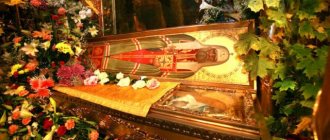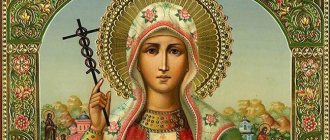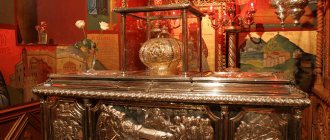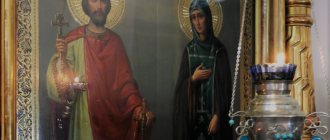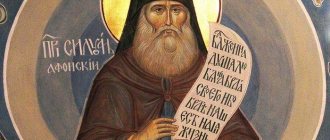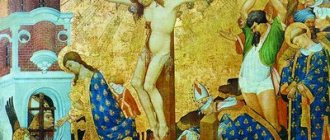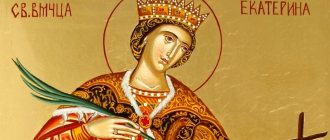Biography of the Holy Apostle
Apostle Thomas is one of the 12 closest disciples and followers of Jesus Christ. Before meeting the Savior, he was called Judas.
Origin
Judas was born and raised in Galilee, in the small town of Pansada, on the shore of a lake. Fishing provided him with food.
How Thomas became an apostle
The life of the saint is described in the Gospel. One day he witnessed Christ preaching on the shore of a lake. Jesus' speeches made such a deep impression on the fisherman that he abandoned his occupation and followed the preacher along with the other apostles. Jesus, seeing such zeal, accepted Judas as his disciple and gave him the name Thomas. Thomas means "twin" in Hebrew.
There are several hypotheses why the apostle received this name:
- due to fused two fingers on the right hand;
- great external resemblance to Jesus;
- had a twin brother.
In the Holy Scriptures the saint is called Thomas or the Twin.
Why Thomas became an “unbeliever”
The saint was an emotional person, which affected his speech and behavior. For example, when Jesus decided to go to Judea, where he could be captured, Thomas alone strongly supported the Savior and was ready to accompany him. The other apostles, on the contrary, discouraged Jesus from taking risks.
The twin was absent the day after the crucifixion of Christ, when the Savior appeared to his disciples and gave them the Holy Spirit with the words that they now had the right to forgive their sins. Thomas doubted the words of his fellow believers, for which he received the nickname “unbeliever.” He stated that only then would he believe in the Divine essence of the Teacher when he saw his wounds with his own eyes and felt his flesh with his hands (wounds on his hands and body).
On the 8th day, the Savior again appeared to his disciples, among whom was an “unbeliever.” Jesus turned to him to verify his identity and plunged his fingers into the wounds. But the shocked disciple refused to do this and from that time on, more than the other apostles, he believed in the teachings of Christ.
Serving God
After the ascension of Christ, the disciples cast lots where each of them should go to preach the commandments of God. The saint had the chance to go to preach in India. The Acts of Thomas, long considered an unconfirmed story by ancient Syrian authors, describes the casting of lots and the subsequent activities of Judas Thomas in India.
The saint refused to go to preach in India, citing health and age. The apostles were forced to turn to Jesus Christ in prayer. The Savior appeared to the apostle in a dream, but this did not help overcome Gemini’s stubborn determination.
During this period of time, Habban, an envoy of the Indian king Gundofar, was in Jerusalem, looking for a European carpenter to build a palace. Jesus Christ appeared to Habban in the guise of a merchant and offered a rebellious disciple in the guise of his slave-architect.
Judas Thomas learned that the Lord had sold him into slavery, and he submitted to God’s will. In India, the king gave him a significant amount of money for the construction of a palace. But the saint, instead of building, began to distribute money and preach the teachings of Christ. When the king was informed that the stranger, instead of building, was healing the sick, helping the poor and drawing Hindus into the new faith, Gundofara became angry and called the apostle to him.
When asked when it would be possible to see the palace, the saint replied that after the death of the king. Thomas was thrown into prison, but was soon released. His dead brother appeared in a dream to Gundofara and said that a beautiful palace had been built for him in the kingdom of the dead. The king accepted baptism from the apostle and released him.
Execution and death
The apostle was slandered by the Brahmins before a local king for converting his wife and son to Christianity. For this he was put to a painful death: on December 19, 72, after torture, he was pierced with a spear in several places; 3 days later, Thomas died from his wounds.
Where does faith come from?
Where does this faith come from? Is it possible to force yourself to believe?
So, with sadness or embitterment, a person leaves this impossible demand and returns to his simple and clear demands - to see, touch, feel, check. But here’s what’s strange: no matter how much he looks, checks or touches, the final truth that he is looking for remains just as elusive and mysterious. And not only the truth, but also the simplest everyday truth.
He seemed to have defined what justice is, but there is no such thing on earth—arbitrariness, the reign of force, ruthlessness, and lies still reign.
Freedom... Where is it? Just now, before our eyes, people who claimed that they possessed real, comprehensive scientific happiness, rotted millions of people in camps, and all in the name of happiness, justice and freedom. And the oppressive fear does not decrease, but increases, and not less, but more hatred. And grief does not disappear, but increases. They saw, checked, touched, calculated everything, analyzed everything, created in their scientific laboratories and offices the most scientific and proven theory of happiness. But it turns out that it does not produce any, even the smallest, simple, real everyday happiness, that it does not give the most simple, immediate, living joy, only everything requires new sacrifices, new suffering and increases the sea of hatred, persecution and evil ...
But Easter, after so many centuries, gives this happiness and this joy. It’s as if they haven’t seen it, and we can’t check it, and it’s impossible to touch it, but go up to the church on Easter night, look at the faces illuminated by the uneven light of the candles, listen to this expectation, to this slow, but so undeniable increase in joy.
Here in the darkness the first “Christ is Risen!” is heard. Here the roar of a thousand voices echoes in response: “Truly he is risen!” Here the gates of the temple open, and light pours from there, and it ignites, and flares up, and joy shines, which can never be experienced anywhere but here, at this moment. “Beauty, rejoice...” - where do these words come from, where does this cry, this triumph of happiness come from, where does this undoubted knowledge come from? Indeed, “blessed are those who have not seen and yet have believed.” And this is where it has been proven and tested. Come, touch, check and feel, you too, you, skeptics of little faith and blind leaders of the blind!
Location of the relics
Until the 4th century, the relics of the apostle were in India.
Then most of the relics were taken to Europe, where they currently rest:
- in the Basilica of St. Thomas (Ortonu, Italy);
- Zion Cathedral (Tbilisi, Georgia);
- Monastery of the Apostle John the Theologian (Greece);
- Afon;
- Hungary.
In India, holy remains are prayed to in the Cathedral of St. Thomas (Chennai).
Why did Peter deny Jesus Christ?
Photo: Pravmir.ru
It may seem that the renunciation was almost accidental, becoming a momentary weakness. Or Peter’s natural instinct of self-preservation kicked in. At the same time, it is undeniable that the renunciation took place; the leader among Jesus’ disciples, at least for a few minutes, admitted that at that moment it was worth giving up his connection with Christ, at least in the minds of those around him. This is a serious crime against the love that binds people together.
Peter almost immediately repented of what he had done. But repentance took time, since it presupposed changes in actions. Peter did not go to Golgotha, where only John is among the apostles. It is not known what he did on Saturday, when the body of the Savior rested in the tomb.
But it is well known that, as soon as he heard about the disappearance of the body, he was among the first to arrive at the burial place. This haste became one of the clearest signs of repentance. Peter did not allow himself to sit at home, immediately going to the place where until recently there had been guards who could well have arrested the followers of the executed prophet.
Orthodox texts
Troparion, tone 2
Having been a martyr of Christ, a participant in the Divine Council of the Apostles, having made known the Resurrection of Christ through unbelief and assured Him of His most pure passion by touch, O all-valid Fomo, and now ask us for peace and great mercy.
Kontakion, tone 4
Filled with the wisdom of grace, Christ's apostle and true servant, crying out to You in repentance: You are my God and Lord.
First prayer
Oh, holy Apostle Fomo! We pray to you: save and protect us with your prayers from the temptations of the devil and the falls of sin, and ask us, the servants of God (names), from above for help in times of unbelief, so that we do not stumble over the stone of temptation, but steadily walk the saving path of the commandments of Christ, until we reach them blessed abodes of heaven. Hey, Apostle Spasov! Do not disgrace us, but be our helper and protector in all our lives and help us end this temporary life in a pious and godly manner, receive a Christian death and be honored with a good answer at the Last Judgment of Christ; Let us glorify the magnificent name of the Father, and the Son, and the Holy Spirit forever and ever. Amen.
Second prayer
O holy servant of God, Apostle Fomo! Having fought a good fight on earth, you have received in Heaven the crown of righteousness, which the Lord has prepared for all who love Him. In the same way, looking at your holy image, we rejoice at the glorious end of your life and honor your holy memory. You, standing before the Throne of God, accept our prayers and bring them to the All-Merciful God, to forgive us every sin and help us against the wiles of the devil, so that, having been delivered from sorrows, illnesses, troubles and misfortunes and all evil, we will live piously and righteously in the present We will be worthy through your intercession, even though we are unworthy, to see good on the land of the living, glorifying the One in His saints, the glorified God, the Father and the Son and the Holy Spirit, now and forever. Amen.
Features of the prayer service
Photo: Pravlife.org
In Christianity, prayer is given great importance, as it is a form of communication with God. Moreover, to perform them it is not at all necessary to go to church: you can read prayers from home, so that communication with the Almighty is as personal as possible.
However, it is emphasized that home prayers do not cancel or diminish the significance of those days when parishioners gather together in church to pray. This becomes a clear manifestation of Christian love for God and for each other. As a result, it is possible to leave behind quarrels and grievances if they have arisen recently.
When people come to church, the saints are invisibly present with them, to whom they turn their prayers. Once next to them, it becomes difficult for a person to keep resentment and hatred within himself. The saints to whom parishioners turn stand next to them at the prayer service, although no one sees them. However, people begin to feel it as God's grace is showered on them. To feel this, prayer must be sincere, only in this case it is guaranteed to be pleasing to the Almighty.
In the Orthodox tradition, a prayer service is also commonly called a “prayer for small things,” since it is a gratitude or petition for a specific matter.
Does the image of Thomas represent ordinary doubt?
Answer: no. If you remember the story, you can understand: the disciple who did not believe in the resurrection of Christ began to argue with the obvious, but incredible, from his point of view. The rest of the apostles saw the wounds with their own eyes. Therefore, life after the death of Christ did not require any more evidence. But the stubborn student still did not recognize the accomplished fact until he was convinced himself. The meaning of the phraseological unit “Doubting Thomas” still suits many people as a characteristic. Most people have stopped seeing miracles around them. They only react to something that strikes their imagination.
Therefore, we will give an example that will truly take your breath away. Imagine one schoolchild told another that an alien ship landed on the roof of his house. Yes, True, a more sensible comrade would have immediately expressed legitimate doubts. But the dreamer, almost immediately offended, retorted: “Oh, you don’t believe me, let’s go to my house, where my parents treat the humanoids with gingerbread and tea!” The boys go to the right place, and indeed: there is a cosmic “plate” on the roof of the house, and the humanoids, having instantly mastered Russian, are already in full swing with the father of the family about the political situation in the country. Silent scene. The lover of truth says to the skeptic proudly and a little (just a little) disdainfully: “But you didn’t believe me, unbelieving Thomas!”
To be fair, it must be said that such a situation is only possible in the stories of a Soviet science fiction writer. In boring everyday reality, everything is more prosaic: one boy does not believe another that his parents bought him a computer or a console. A girl questions a report that her friend's husband has been promoted at work. In other words, there are a lot of such examples that can be drawn, but they are not interesting.
Types of prayers
Photo: Nevsky22.ru
There are several types of prayers:
- about health;
- grateful;
- about the end of the war;
- about travelers;
- about ending the drought.
In addition, prayer services differ in how they are conducted. In this case they are:
- simple;
- holy of water;
- thanksgiving;
- Akathist.
A simple prayer service is dedicated to some saint. During this type of service, a litany is said in honor of the Mother of God. During it, the names of the parishioners who ordered the prayer service, as well as their relatives, are mentioned. Afterwards, a prayer is read, intended for the saint to whom it is dedicated. A simple prayer service is ordered for the health of a person who is currently ill or on the occasion of a name day.
It is customary to hold a thanksgiving prayer service on important and significant church holidays. However, it is possible that a parishioner will order it on his own, wanting to give praise to the Almighty.
Akathist prayers are usually held in front of especially revered and miraculous icons, as well as on the days of remembrance of great saints. Such prayer services are held according to a schedule that is posted at the entrance to the monastery or temple.
Also, prayer services may differ depending on who they are addressed to. The options are as follows:
- to the Almighty;
- to the Saints;
- to Our Lady.
Comparison with the betrayal of Judas Iscariot
Photo: Ikonaspas.ru
Since then, according to legend, Peter’s eyes have always remained red. This was due to the fact that until the end of his life he began to cry every time he heard a rooster crow. This is the best evidence not only of repentance, but also of the repentance that followed it.
Moreover, Peter’s denial is a sin of human weakness. A sin that every person faces sooner or later. If, after committing it, the believer sincerely admits it to himself and repents, then he will be forgiven by the Lord.
The sin that Judas committed is of a different nature. This is a sin of human choice, which can be committed in favor of betrayal and obtaining specific material gain. Or you can stay away from it. This is not the case when everything happens instantly, it seems as if you were in a fog. This is a sin committed consciously in a sober mind and strong memory.
Father and son
My son is not doing very well at school. Let's just say he's an average student. And suddenly he comes home and says to his father:
Dad, did I get an A in Russian?
Well, yes, tell me.
Can I prove this with a journal entry?
The son puts the diary in front of his father, who opens it and sees a miracle - an excellent mark!
Silent scene.
So, are you ashamed, father? Eh, you - Thomas the unbeliever!
We discussed the meaning of the phraseological unit and its origin a little higher.
Giving Thanks to God
Photo: Hramvkostino.ru
If faith for an Orthodox Christian is a kind of medicine, thanks to which he can atone for his sins, then gratitude is evidence of the important religious experience gained by a parishioner. Any communication with the Lord should always be imbued with a feeling of gratitude; this is one of the prerequisites for sincere prayer addressed to the Almighty
Any believer should feel gratitude, even if he has not committed sins for which he must repent.
At each liturgy, an angelic song is pronounced, which speaks of the importance and necessity of worshiping the Almighty, offering him praise and gratitude. The Revelations of John the Theologian describes the heavenly liturgy, in which the righteous give thanks to the Almighty together with the angels
The Divine Liturgy celebrated in churches is called the Eucharist, which translated from Greek means “thanksgiving.” Parishioners at the service, unfortunately, often do not pay attention or do not listen to the texts of the prayers that the priest reads from the altar during the liturgy.
A conscious Christian must necessarily read, study and understand what is said in these prayers so that his participation in the liturgy is conscious. The main theme of the prayers heard at the liturgy is gratitude to the Lord for all his explicit and implicit deeds aimed at the benefit of believers. All these prayers begin with a single call from the priest addressed to the flock: “We thank the Lord!”
If a parishioner repeats the texts of the prayers pronounced at the liturgy, understands and realizes their meaning, this will be one of the most effective and correct ways for a believer to offer thanks to the Lord.


